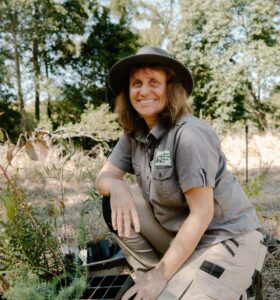
New research is underway to address the invasive spread of gazania, commonly known as the African daisy, in grain paddocks across Australia. Supported by the Grains Research and Development Corporation (GRDC), this initiative aims to identify effective chemical control options for growers facing challenges from this aggressive weed. Concerns regarding gazania were raised by growers through the National Grower Network, prompting this focused research effort.
Introduced to Australia from South Africa as a resilient garden flower, gazania has adapted well to the local environment. It thrives in fragile, sandy soils and is known for its drought resilience. However, its rapid spread is alarming, particularly in areas with poorly managed soils, such as roadsides and fence lines. Currently, it is infesting grain crops in regions including the Eyre Peninsula and Yorke Peninsula of South Australia, as well as parts of the New South Wales Riverina and Western Australia.
Robin Schaefer, a grower from Loxton, South Australia, has witnessed the dramatic encroachment of gazania in the northern Mallee region. In less than a decade, what began as isolated plants from domestic gardens has turned into widespread infestation. “They would spread along the roadsides and we’d see the odd plant pop up in our paddocks,” Schaefer explained. “Initially, we didn’t pay much attention, but they slipped through our weed control program.”
Over recent years, significant rainfall events have further facilitated the germination of gazania during the fallow period when competition from crops is low. Dr. Ali Bajwa, a Senior Lecturer in Weed Science and Agronomy at La Trobe University, has conducted extensive surveys to map the infestation trends across southern Australia. His research indicates that a single gazania plant can generate a substantial seed load each season, with seeds easily spread by wind, water, and animals.
“Some aspects of our rotation system may have aided the spread of gazania, and conventional weed control methods have proven ineffective,” Schaefer noted. He highlighted the plight of local farmers, stating that at least one has been unable to cultivate several paddocks for up to three years due to the overwhelming presence of gazania.
Gazania plants are perennial, capable of forming dense monocultures that outcompete native vegetation and crops. They reproduce through underground rhizomes and generate thousands of windborne seeds annually. The resilience of these plants complicates control efforts; physical removal often fails, while the waxy leaves hinder the absorption of herbicides, leading to inadequate control.
Research conducted over the past two years by Dr. Bajwa and his team has focused on evaluating herbicide options across various growth stages of gazania. Initial findings suggest that certain knockdown herbicides can effectively target young plants in the 2-4 leaf stage. However, effectiveness diminishes sharply as plants mature. Controlling mature plants with over 20 leaves has proven nearly impossible with most chemicals. Dr. Bajwa noted that gazania displays natural tolerance to commonly used nonselective herbicides like glyphosate and paraquat.
Despite these challenges, promising results have emerged from trials of herbicides with residual activity. Data from extensive glasshouse and field trials indicate that specific combinations of group 4 and group 14 herbicides may offer viable control options. Nevertheless, as no herbicides are currently registered for gazania, further validation of these findings is essential before any recommendations can be made to growers.
In the interim, Dr. Bajwa advises growers to take proactive measures by eradicating any gazania found along fence lines or in paddocks. He suggests digging out and burying or burning individual plants, along with applying suitable nonselective herbicides for small infestations. Additionally, he has noted that lentils and other legume crops might weaken gazania management, emphasizing the need for enhanced weed control in these areas.
Maintaining good farm hygiene when moving equipment or livestock from infested regions is crucial in preventing the spread of seeds. The urgency of addressing the gazania issue has been underscored by its presence next to grain production areas in various regions. Dr. Bajwa stated, “Gazanias need national action, as they are already present next to grain production paddocks in the southern, northern, and western regions.”
The challenges posed by gazania were highlighted during the GRDC National Grower Network Forums in South Australia in 2023, following the significant wet season of 2022. Shortly after, WeedSmart Southern Extension Agronomist Chris Davey provided GRDC with an informal survey mapping roadside gazania populations near grain production paddocks across Western Australia, South Australia, and Victoria.
Ruth Peek, Crop Protection Manager for GRDC – South, emphasized the importance of the National Grower Network as a channel for growers to voice their concerns. “Once we were made aware of the issue, GRDC partnered with Dr. Bajwa and his team to further research gazanias and explore possible control options,” she stated. “Gazanias have quickly become a significant concern for growers in various regions, and Dr. Bajwa’s research is crucial in evaluating control strategies. His findings will guide future investments in gazania management.”
As the research progresses, the need for a comprehensive integrated weed management strategy becomes clear, ensuring that grain growers can effectively combat the challenges posed by gazania and protect their crops.







